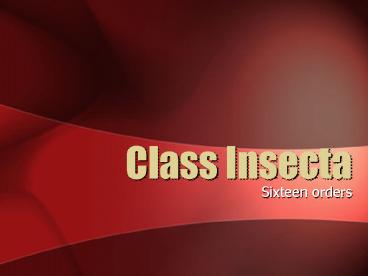Class Insecta - PowerPoint PPT Presentation
1 / 21
Title:
Class Insecta
Description:
E (soil or plant tissue), N2-4, A. Predators. spined ... Order Lepidoptera. Moths & butterflies. Complete. Larvae chewing. Adults siphoning. 2 pairs wings ... – PowerPoint PPT presentation
Number of Views:212
Avg rating:3.0/5.0
Title: Class Insecta
1
Class Insecta
- Sixteen orders
2
Order Thysanoptera
- Thrips
- Intermediate
- Raspingmouthparts
- Flower buds
- enclosed spaces
- 4 Feathery wings
- poorlydeveloped
- Vectors
- Some predaceous
3
Order Thysanoptera
- Intermediate
- E, N1-2, Pre, Pseudo, A
- Eggs in plant tissue
- 2 active larvaeprepupae pseudopupae in the
soil - Adults onplants
4
Order Homoptera
- Aphids, scales, whiteflies, cicadas
- Incomplete
- Piercing-sucking mouthparts
- Secrete honeydew
- Whiteflies
- scale insects
- APHID INFO
- Apical meristems
- New growth
- Low N
- Complex L.C.
- E (overwinter),
- none in summer,
- N2-4, A
- Appendages
- cornicles
- cauda
5
Order Homoptera
6
Order Homoptera
- Intermediate Life Cycle
7
Order Hemiptera
- True bugs
- Incomplete
- Piercing-sucking
- Triangular scutellum
- 4 wings (hemelytra)
- E (soil or plant tissue), N2-4, A
- Predators
- spined shoulders
8
Order Orthoptera
- Grasshoppers crickets
- Incomplete
- Chewing mouthparts
- 2 pairs of wings
- -outer leather
- -inner membranous
- E, N2-4, A
- Hind legs modifiedfor jumping
- Abdominal cerci
- Tympanum
9
Order Coleoptera
- Beetles weevils
- Complete
- Chewing mouthparts
- 4 wings
- 1st pair hardened shell elytra
- E, L2-4, P, A
- Chewing larvae adults
- Weevils have snout
10
(No Transcript)
11
Order Lepidoptera
- Moths butterflies
- Complete
- Larvae chewing
- Adults siphoning
- 2 pairs wings
- Covered in scales
- E (on/in plants), L2-4, P, A
- Moths
- Filamentous antennae
- Wings held flat
- Butterflies
- Clubbed antennae
- Wings folded up
12
Order Hymenoptera
- Ants, bees, wasps, sawflies
- Complete
- Larvae chew
- Adults chew suck
- 4 wings
- Social insects
- Pollinators predators
- Female stingers,ovipositors
13
Order Diptera
- True flies
- Complete
- Adults have biting,sucking, spongingmouthparts
- Maggots have hook
- 1 pair wings
- Halteres
- Complete
14
Order Dermaptera
- Earwigs
- Incomplete
- Chewing mouthparts
- Squirt foul liquid, inflict pinches
- Few have functional wings
- Omnivorous
- Nocturnal
- Abdominal forceps
15
Order Phasmatodea
- Walkingsticks/ stick insects/ leaf insects/
phasmids - Incomplete
- Defense tactics
- Noise
- Smell
- Postures
- Colouration
- Shedding legs
- Some species
- Winged
- Reduced wings
- Wingless
- Temperate zones
- No control necessary
16
Order Neuroptera
- Lacewings antlions
- Complete
- Beneficials
- 4 wings (finely veined)
- Larvae are cannibalistic
- Adults eat pollen,nectar or honeydew
17
Order Odonata
- Dragonflies
- Incomplete
- All stages predaceous
- 2 pairs of wings
- Naiads
18
Order Mantodea
- Mantids, praying mantis
- Incomplete
- Beneficial
- Large front legs
- Spined for holding prey
- Uses camouflage
- o/w in egg sac
- One generation/yr
19
Order Collembola
- Springtails
- None
- Egg
- Young just smaller than adult
- Wingless
- Furcula
- Scavengers
- Decompose organic matter
- Most abundant soil-dwellers
- Less than 6mm
20
Order Isoptera
- Termites (subterranean, rottenwood)
- Incomplete
- Only hemimetabolous insect that exhibits true
social behaviour - Decomposers
- Cannot digest wood fibers
- Digestive system contains symbioticprotozoa or
bacteria - Termites live on the by-products
- Annual loss in US
- 800 million
21
Order Blattodea
- Cockroach
- Incomplete
- Cosmopolitan
- Human pathogens
- Research tools
- Physiology
- Toxicology
- dander allergies
- Nocturnal
- Madagascar hissing































